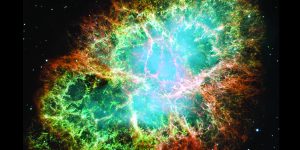Chapter 10: Modern Atomic Theory
Enhanced Introductory College Chemistry
by Gregory Anderson; Caryn Fahey; Jackie MacDonald; Adrienne Richards; Samantha Sullivan Sauer; J.R. van Haarlem; and David Wegman;
Chapter Contents
- 10.1 Electromagnetic Radiation
- 10.2 The Bohr Atom
- 10.3 Wave Nature of Matter
- 10.4 Quantum-Mechanical Model of the Atom
- 10.5 Atomic Structures of the First 20 Elements
- 10.6 Atomic Properties and Periodic Table Trends
- Summary
- Review
Except where otherwise noted, this OER is licensed under CC BY 4.0
Please visit the web version of Enhanced Introductory College Chemistry to access the complete book, interactive activities and ancillary resources.
In this chapter, you will learn about
- The nature of electromagnetic energy/radiation
- The Bohr model of the atom, how atoms emit light, and how the emission spectrum of hydrogen supports the quantized nature of energy
- Wave nature of matter and the development of the quantum mechanical model
- Energy levels of electrons, shapes of orbitals, and development of the wave mechanical model
- The atomic structure of the first 18 elements and how principal energy levels fill with electrons in atoms beyond hydrogen. You will write electron configurations according to an element’s electron filling order.
- Electron structures/configurations of atoms with atomic numbers greater than 18.
- Understand and predict general trends in atomic properties in the periodic table
To better support your learning, you should be familiar with the following concepts before starting this chapter:
- Rutherford’s nuclear model of the atom including its subatomic particles of an atom
- Structure of the hydrogen atom
- Use the periodic table to identify the number of electrons in neutral atoms for various elements
- Identify group/family names and numbers on the periodic table
- Review common trends in periodic table including physical and chemical properties of metals and non metals and ion formation

In 1054, Chinese astronomers recorded the appearance of a “guest star” in the sky, visible even during the day, which then disappeared slowly over the next two years. The sudden appearance was due to a supernova explosion, which was much brighter than the original star. Even though this supernova was observed almost a millennium ago, the remaining Crab Nebula (Figure 10.0a) continues to release energy today. It emits not only visible light but also infrared light, X-rays, and other forms of electromagnetic radiation. The nebula emits both continuous spectra (the blue-white glow) and atomic emission spectra (the coloured filaments). In this chapter, we will discuss light and other forms of electromagnetic radiation and how they are related to the electronic structure of atoms. We will also see how this radiation can be used to identify elements, even from thousands of light years away.
Attribution & References
Except where otherwise noted, this page is adapted by Jackie MacDonald from “Ch 6. Introduction” In Chemistry 2e (Open Stax) by Paul Flowers, Klaus Theopold, Richard Langley & William R. Robinson is licensed under CC BY 4.0. Access for free at Chemistry 2e (Open Stax).
References
Hester, J., & Loll, A. (2017, August). The Crab Nebula. NASA.

